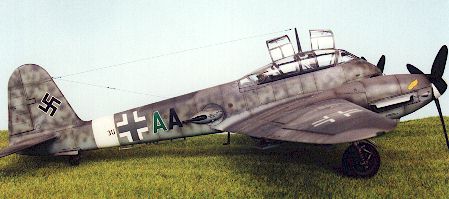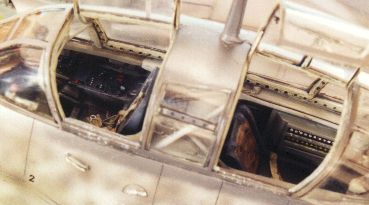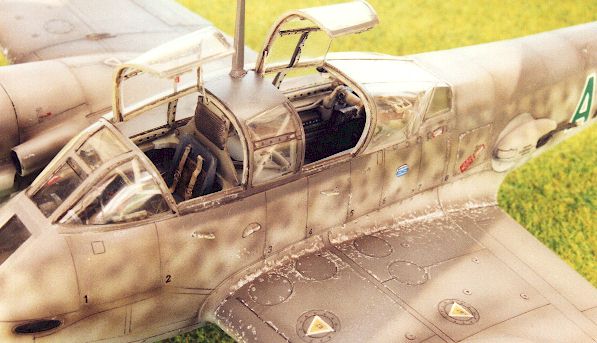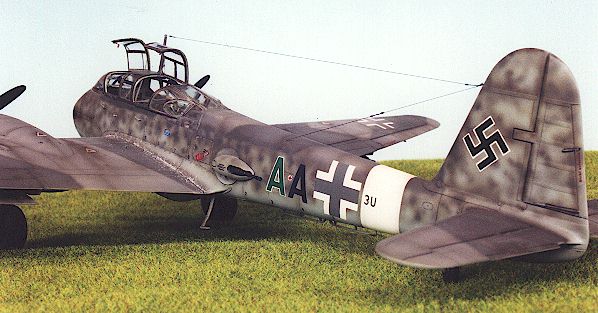|
Messerschmitt Me 410B-1 |
Messerschmitt Me 410B-1
Model
by Chris Wauchop
Review by Brett Green
|
Messerschmitt Me 410B-1 |
Four more images in the text
| B a c k g r o u n d |
The Messerschmitt Me 410 was the last in the line of purpose-built German Zerstorer (Destroyer) - twin-engined heavy fighters. It was a direct development of the fairly disastrous Me 210, which was in turn intended to replace the Messerschmitt Bf 110 as early as 1940. Ironically, while the last Me 410 was being withdrawn from service by the end of 1944, the Bf 110 soldiered on in considerable numbers as a night fighter until the last days of the war.
The Me 410 A corrected most of the potentially fatal problems of the early Me 210. Although similar in appearance, the new aircraft boasted more powerful engines, a longer and deeper fuselage, swept-back outer wing panels, revised flaps, improved ailerons and automatic wing slots. The Me 410 B series featured the new DB 603G engines which each developed 1,900 hp at takeoff. The first Me 410 B series was available in April 1944.
This new, powerful platform was equipped with a variety of weapons. Optional Ruststatze (Field Conversion Sets) included the choice of 2 x 30mm MK 103 cannon, 2 x 20mm cannon in a belly-pack, external bomb racks or 4 x W. GR-2 Rocket Tubes mounted under the wings. The Me 410 could even be equipped with a 50mm BK 5 cannon for use as a "tank buster". It was fairly common to see combinations of these field-modified weapon options on one aircraft.
 Another distinguishing feature
of the 210/410 series was the remotely controlled, rearward firing 13mm MG 131 machine
guns in barbettes on each fuselage side.
Another distinguishing feature
of the 210/410 series was the remotely controlled, rearward firing 13mm MG 131 machine
guns in barbettes on each fuselage side.
Many of the Me 410 B series operated on the Southern Front over Hungary, Austria and Southern Germany. The principle role of the Hornisse in this theatre was to counter American daylight bombing. Despite the impressive weapons fielded by the Me 410, it was no match for the more nimble American escort fighters and suffered heavy losses accordingly. The Me 410 also operated in the night intruder and even night fighter roles.
Ultimately, however, the fate of the Zerstorer on the Western Front was predicted over the skies of Great Britain in 1940. The concept simply took four years to lay down and die!
| I n - t h e - B o x |
ProModeler's 1/48 scale Me 410 contains around 131 parts in grey styrene on three sprues, 13 parts on one clear sprue and decals for three aircraft. The clear parts are packed in a separate plastic bag. Optional parts are provided for 4 x W. GR-2 underwing rocket tubes, an R-4 underbelly gun-pack and a choice of either 2 x MG 151 20mm cannon or MK 103 30mm cannon for the nose armament. The 30mm option comes complete with the corresponding telescopic sight and alternative forward canopy.
Surface detail is by way of very crisp panel lines combined with subtle and appropriate raised rivets, hinges and tape. There are a series of small, raised circles on the horizontal tail surfaces which are at best over-scale, and at worst completely fictitious! Light sanding will correct this problem - but be careful not to remove the rest of the detail.
There are no sink marks apparent on my example. Ejector pin marks are fairly feint and mainly restricted to areas that will not be seen on the completed model.
The dimensions and accuracy of the outline are good, with only a couple of nit-picks. The supercharger intakes on the engine cowlings are too long and are oval in profile. They also point down too steeply and consequently touch the top of the exhaust assembly. The modeller may choose to conduct some minor surgery or leave the intakes as they are. In addition, Charles Metz advises that the shell ejector chutes are incorrectly angled horizontally instead of vertically. He suggests that the fuselage may be about 1mm too deep, and that the problem could be corrected by widening the chutes toward the aircraft's centreline.
 Kit detail is excellent. The
cockpit is comprehensive with convincing radio gear, instruments, remote barbette
controls, roll bars and very comfortable looking quilted cushions on the pilot's and radio
operator's seats! Lap harnesses are moulded onto the pilot's seat only, but this doesn't
really work - they appear too flat. Both cockpits look very busy and accurate.
Kit detail is excellent. The
cockpit is comprehensive with convincing radio gear, instruments, remote barbette
controls, roll bars and very comfortable looking quilted cushions on the pilot's and radio
operator's seats! Lap harnesses are moulded onto the pilot's seat only, but this doesn't
really work - they appear too flat. Both cockpits look very busy and accurate.
External detail is equally good. Tyres are bulged and hydraulic hoses are attached to the main gear legs. The wing radiator detail is particularly impressive. Another nice touch is that ProModeler have provided the machine guns with a centred hole in the end of each barrel - no drilling-out required. Unfortunately you will have to drill out the exhaust stacks (if you are that way inclined).
Two excellent figures are also included. If you don't like the seated pilot figure, the standing radio operator offers some vignette potential.
The only slightly disappointment is the wheel well detail. These are depicted with only the small forward flap open. To be fair, the vast majority of wartime photographs do show the main gear doors closed when the 410 was on the ground, but it means that the kit wheel well is correspondingly small. The wheel wells should be wider and extend rearward from the front undercarriage-door aperture, with a circular opening in the lower surface of the wing to accomodate the retracted wheel. The main landing gear of the Me 410 rotated 90 degrees during retraction, similar to a P-40 or Hellcat.
| C o n s t r u c t i o n |
ProModeler's Me 410B kit is quite straightforward in construction. Fit of components is very good. Chris chose to make only a few additions to the kit. Most modifications were made to the cockpit and canopy.
Here is a summary of Chris's modifications and corrections:
A locking device for the tailwheel was added to the port side of the cockpit. This cylindrical device was made from scrap styrene. Harnesses for both seats were made from lead foil with separate etched metal buckles.
In Step 3, the instructions advise to glue all three Revi gunsights on back-the-front. Even if the lower two sights were arranged for reflection, I can't see how the top mounted sight could possibly work facing in this direction. Suit yourself for the positioning of the bottom two sights, but I'll bet the top one should be installed the opposite way to the instruction diagram!
Two grab handles were added to the port fuselage
sides under the cockpit. These were bent from fine brass wire. Brass tube was used to
represent MG barrels behind the empty ports below the front window.

The brackets mounting the pilot's armoured glass place this clear panel way too far
forward. The glass should be positioned almost vertically, and directly in front of the
pilot. A good photo showing the correct position may be found at the top of page 43 of
Squadron's "Messerschmitt Me 210/410 in Action". Chris simply cut off the kit
arms and added shorter items from styrene strip.
In Step 10, the canopy must be assembled exactly according to the instructions. The canopy sides have to be brought together to "capture" the wide remote gunsight. If you (like Chris) assemble the canopy separately you (like Chris) will have a very frustrating time trying to fit it over the gunsight assembly! Tamiya non-fogging Cyano Glue was used to secure these clear parts.
Additional detail on the canopy included lock down handles from plasticard and stretched sprue, struts for the open canopy sections and grab handles on the each side of the inside of the pilot's windscreen.
| P a i n t a n d D e c a l s |
The painting instructions do not reflect the very high standard of the rest of this kit. They are misleading to say the least. They depict a single colour camouflage on the upper fuselage deck, all RLM 74 upper engine nacelles and sparse, spotty mottling on the fuselage sides. Wrong on all counts.
The marking guide also suggests that two of the Me 410 B-1 subjects are in service during late 1943 and February 1944, some months before the B-1 variant first entered service! It is more likely that these subjects are actually A-1 variants. This error is not surprising, as there is nothing external to distinguish an A-1 from a B-1 (as far as I can tell).
Having said all that, these painting instructions are at least an improvement over the bizarre camouflage and markings suggested in the recent ProModeler Bf 110G-4 kit!
The decals themselves are nicely printed and conform well to a painted surface, but the black and white are slightly out of register on all the examples that we have seen. Chris used only the stencil markings from the kit.

The remainder of the decals were sourced from Aeromaster's Set Number 48-360 "Me 410 Hornisse Collection Part 3". Chris has chosen a Staff aircraft of I./ZG.26 during late 1944. The standard Me 410 scheme is applied - segmented 74/75 on the upper surfaces (including segmented camouflage on the fuselage spine) and a heavy, indistinct mottle of 02, 74 and 75 on the fuselage sides.
| C o n c l u s i o n |
Monogram earned an enviable reputation during the 1970s and early 1980s for its ambitious multi-engined subjects and excellent interior detail. Who could forget the fabulous 1/48 scale B-17, B-25 and C-47? However, they lost ground to the high technology moulding techniques of Tamiya and Hasegawa over the following ten years. Nobody wanted to know about a kit with raised panel lines - regardless of how large, accurate or simple to build.
ProModeler have continued Monogram's proud tradition of interesting subjects, extensive interiors and added crisp, state-of-the-art surface detail to the mix.
This excellent kit is thoroughly recommended.
| R e f e r e n c e s |
Messerschmitt Me 210/410 in Action
by George Punka. Squadron Signal Publications, Carrollton Texas, 1994
ISBN 0-89747-320-5
The Complete Book of Fighters by
William Green and Gordon Swanborough. Salamander Books Limited, London, 1994
ISBN 0-86101-643-2
Wings Magazine, Volume 13, No. 1
Thanks to Charles Metz for his clarification of wheel well details
Several Web Pages are devoted to the Me 210/410. History and service, plus detail photographs, are available at Lorenz Barmann's "Messerschmitt Me 410 Resource Page". Worth a look.
Back to HyperScale Main Page
Back to Features Page